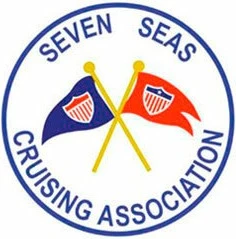
When I teach seamanship classes, I eventually get around to the fact that the sea is a dangerous and hostile place – but, if prepared, you can increase your odds dramatically if you view yourself as an astronaut on a faraway planet. Help is on the way. It will take time to get to you. What have you done to stay alive while the rescue team is heading for you? This column is about those steps.
Leave Her When She Has Sunk from Beneath You
The advice I always give to mariners is, “Never leave the boat, even if you can only cling to her up-turned keel until she has sunk out from under you.” It is hard to imagine how much easier it is to find an overturned hull than it is to find your lonely head peering out from the waves – and it isn’t easy to find that hull. It is like crossing the street at night.
You can see the headlights of the car racing down the street quite clearly. But the driver can’t see you, especially if you are blending into the night’s colors. While you are bobbing in the waves, you can see the plane, helicopter, or rescue boat – but your head can easily blend it with the waves and wave-caps, especially if you have no distinctive coloring or reflective material to help you stand out from the steely blue and white of wind-tossed seas.
So, unless the vessel has sunk beneath you, stay with her. And get up on her if you can since water will draw your body heat from you 25 times faster than air of the same temperature.
Thar’ She Goes – Time to Leave
There will be conditions, Heaven forbid, when you must abandon ship. Do you have a “ditch bag?”
What’s that? This is a bag – preferably water-proof – that contains as much vital material as you can bring.
Remember, you’re marooned on Mars and it will take time for the rescue rocket to get to you – will you survive until help gets there? What should be in your ditch bag? Well, obviously, priorities are implied since you can't drag the entire boat with you – she must have disappeared beneath the waves by now.
Here are some thoughts:
- Per above, the bag itself should be water-tight. Buoyant and brightly colored is an absolute “yes” too! If you don’t have a raft, the bag itself will work as a supplemental life-jacket, keeping you above water.
- Drinking water. You can survive for weeks without food; without water? Days.
- Water-proof handheld VHF radio; maybe it comes with a hand-cranked charger too?
- If your cell phone isn’t water-logged, it might make a lot of sense to have a hand-cranked charger.
- First-aid kit
- Flashlight and spare batteries
- Flares, flares, flares – and only set them off when you can see the rescue team/vessel/plane/helicopter. day-smoke distress signals are great too.
- A signaling mirror might even be more useful than day-smoke distress signals since you can throw a mirror’s light signal for miles.
- If your boat had an EPIRB aboard, take it with you – and a handheld radio.
- Your life jacket should be on, not in the bag.
Done, Now What?
Now the question is this: How hard – or easy – have you made it for others to find you? Coloration matters so be sure that your life-jackets, flotation devices and your ditch bag are brightly colored and have reflective materials attached.
Also, if you haven’t invested in an EPIRB yet, consider it. There is nothing like having your own gear and ensuring that it is always in readiness. What used to be over $1,200 is now in the mid-hundreds. Over a 5-10 year life, what could be a cheaper or more reliable “come and get me!” beacon? What a pity it would be to survive the initial catastrophe, including getting off the may-day – but no one can find you and your crew.
Think like an astronaut. You have to survive the rescue cycle – and you have to be found by determined parties searching for you in a dangerous and hostile environment.
If you have any comments on this column or are interested in being part of USCG Forces, email me at [email protected] or go direct to the D1SR Human Resources department, who are in charge of new members matters, at DSO-HR and we will help you .get in this thing.











